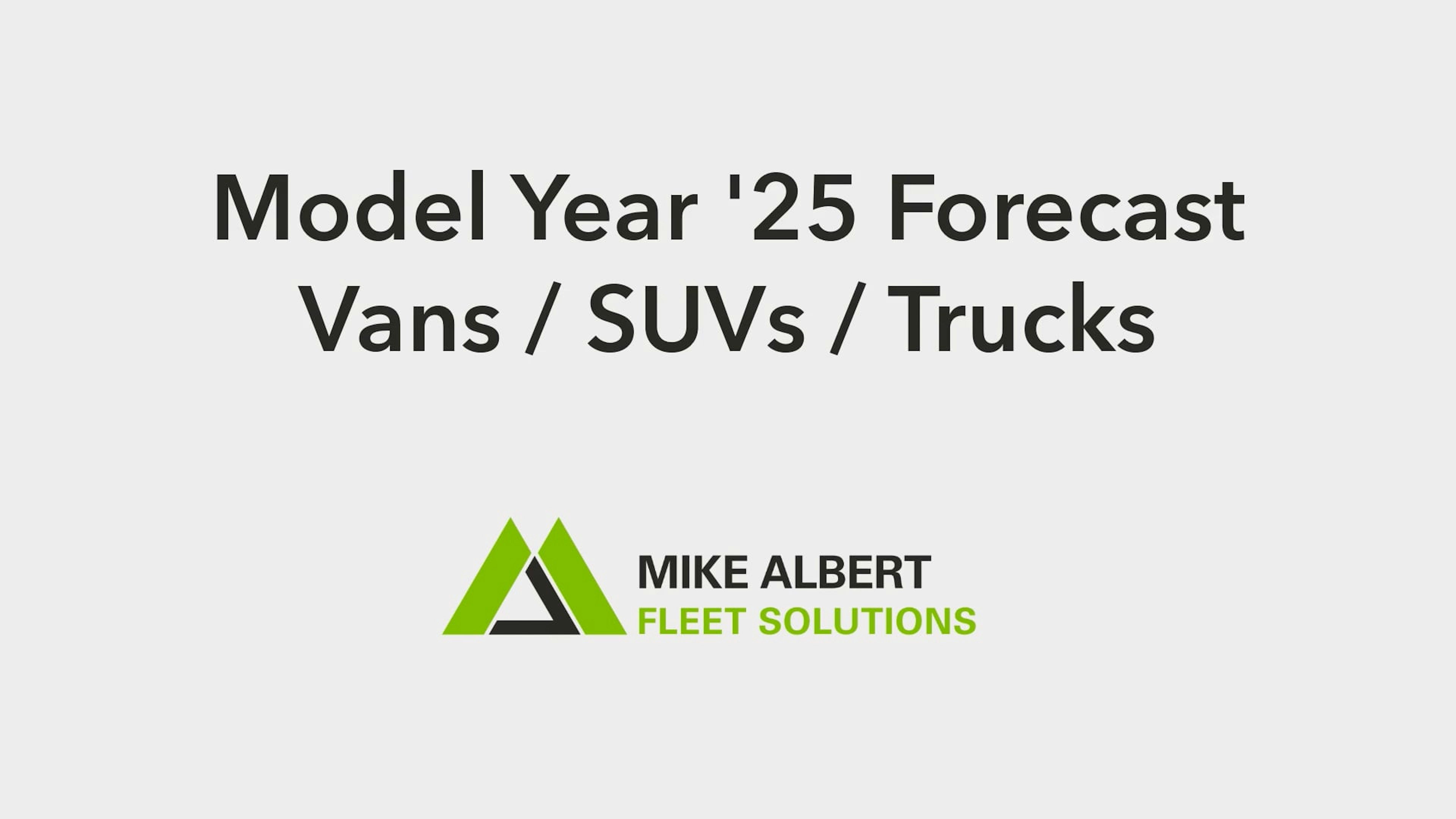Auto & fleet industry: Summer Update - What to expect through 2024
Fleets are undergoing significant changes, but we may see a return to a new normal this year. What trends and updates are we seeing—and can expect to see—through the rest of 2024? We talked to a couple of our fleet experts to find out.

The auto sector and fleet world are undergoing significant changes, but we may see a return to a new normal this year. What trends and updates are we seeing—and can we expect to see—through the rest of 2024 and into 2025? We talked to our fleet experts, Lars Nielsen, Regional Vice President of Fleet Sales, and Jason Kraus, Director of Vehicle Acquisition & Lease Structure, to find out.
Persistent supply chain issues—potentially coming to an end?
*updated 07/17/2024
Since COVID-19, shortages of vehicles, parts, and aftermarket equipment/upfit have left many fleet managers scrambling to source (and upfit) new vehicles, repair existing ones, and keep fleets operating efficiently. There are some positive signs pointing towards pre-2020 levels:
- Production levels continue to improve, Even halfway through the year, the National Association of Fleet Administrators (NAFA) is still forecasting that 15.9 million units will be sold in 2024. This is up from 14.4 million in 2020 but is still well below the 17.1 million produced in 2019.
- Some specific vehicle types, like cars and sport utilities (SUVs), are back to average production and dealer inventory. Other types, like pick-up trucks and vans, are improving but are still low in stock. In particular, demand for 2024 vans still far exceeds current production, and fleet managers are struggling to find fleet-configured vehicles.
For more information on model year 2025 forecasts and the current state of production, hear from Kraus in these Fleet Studies Lab articles:
- Electric Vehicles: What to Expect in the Auto & Fleet Industry for MY2025
- Fleet Vehicles: What to Expect in the Auto & Fleet Industry for MY2025
- Medium & Heavy-Duty Commercial Vehicles: What to Expect in the Auto & Fleet Industry for MY2025
Tax credits are subject to further restrictions.
*updated 07/17/24
The economy has been topsy-turvy the last four years, but it seems as though things will begin to even out. Both interest rates and inflation have decreased but aren’t quite at the goals the Federal Reserve is looking for. The Fed is choosing to hold steady on interest, between 5.25 and 5.5%, while also signaling potential cuts later in the year. The Federal Reserve Bank of Atlanta’s GDPNow model estimates that the current gross domestic product (GDP) has grown 0.6% from Q1 to now.
It is also important to be aware of the Inflation Reduction Act of 2022, which extends the EV tax credit through 2032, allowing millions of people and companies to benefit. This is big news, as the previous tax credit had already ended for “trailblazer” EV manufacturers like Tesla and General Motors. With the tax credit back in play, “it gives fleet owners a competitive edge from a TCO perspective,” Nielsen says
However, be aware—new restrictions will affect the EV tax credit. As of January 1, 2024, fewer EVs will qualify for the total price. To receive the full $7,500, EVs must follow these rules:
- Assembly must be in North America, including the battery.
- Be under a specific price point—for cars, it’s less than $55,000, and for SUVs and trucks, it’s less than $80,000.
- A certain percentage of battery materials must not be mined or processed from countries hostile to the United States, such as China, Russia, North Korea, and Iran.
Vehicles that adhere to the price and one of the two other requirements will only be eligible for half of the tax credit, or $3,750.
Some popular vehicles, like the Chevrolet Bolt, the Ford F-150 Lightning, and most Tesla Model Ys, still qualify for the full credit amount. Others, like the Rivian R1S and R1T, can only claim the partial credit. Many other popular vehicles didn't make the cut, including the Ford E-Transit, the Nissan Leaf, and all of Volkswagen’s EVs. For a complete list of qualifying EVs, visit here.
In response, some manufacturers have lowered prices to maximize the opportunity for consumers, while others have increased prices on EVs that don’t qualify. Fleet owners should remember that “decreases in vehicle pricing often hurt residual values,” says Jason Kraus, Director of Vehicle Acquisition & Lease Structure.
EVs—here to stay or slowing to a crawl?
While state and federal governments are still interested in making dedicated efforts for full zero-emission fleets, carmakers and companies are stepping back from current EV plans. Most recently, Ford announced it would reduce the number of workers at its Rouge Electric Vehicle Center in Dearborn, Michigan, pulling back on its F-150 Lightning. Other OEMs (original equipment manufacturers) that once had aggressive plans, like General Motors, Volkswagen, and Volvo, are scaling back production to suit consumer needs. The main reason for this is declining gas and diesel prices—EVs were more appealing when gas was $5 a gallon, but now that it's back down to $3, it doesn’t seem “worth it” for the average consumer to purchase an EV.
At the same time, though, EVs had their best-selling year ever in 2023, with a record 1.2 million units sold in the United States. Analysts predict that 2024’s numbers will beat out 2023, with Cox Automotive calling 2024 “the Year of More.” Another study from the International Energy Agency looking at EV trends forecasts that electric car sales in the United States will rise by 20%.
So, what does that mean for fleets? Kraus urges fleets to recognize whether a shift to EVs suits their company.
“Just as your investment advisor would recommend having a balanced portfolio, I’d suggest you consider this approach to your fleet operations,” he says. “There is a lot of talk about EVs, but it’s more important to recognize the different types of powertrains and consider what may or may not be an appropriate addition to your fleet.”
The three alternatives to internal combustion engines (ICE) include hybrid, plug-in hybrid and EVs. Hybrids are often appropriate for fleets beginning their electric journey—these vehicles have better fuel economy but don’t require investment in charging ports. Plug-in hybrids are a good step up for commuting employees with home or depot charging access. Finally, EVs can be a good fit depending on the vehicle segment needed, daily mileage, payload and towing requirements, ambient temperature, and access to charging. However, for fleets looking to invest in EVs, creating a charging depot would also be a good idea, as public charging can be expensive and unreliable.
Cleaner heavy-duty truck EPA requirements are on the horizon.
*updated 04/17/24
However, whether it’s sticking to ICE or switching to electrification or one of the alternatives like hybrids or hydrogen, fleets using heavy-duty vehicles may have to make a choice soon—new “Phase 3” greenhouse gas pollution standards were published by the EPA at the end of March, building on the Heavy-Duty Phase 2 program from 2016. These new standards will require truck manufacturers to reduce emissions in 2027 to 2032 model-year vehicles by choosing one of the clean alternatives, whether it’s electrification, hydrogen, or hybrid. The EPA will also give manufacturers more time to develop specific infrastructures and technologies, pulling back on ramping up clean truck production by 2030.
As the push toward electrification continues, there’s another interesting opportunity to keep an eye on: the data that can be harvested from charging stations. “We already have telematics partners and charging infrastructure partners that can pull some really interesting data from EV charging stations,” Nielsen says—including things like duration of charge, miles and kWh added during a session, and amount of CO2 avoided. That data can be used to make critical business decisions that improve efficiency, productivity, and decarbonization efforts.
The compact van is officially gone.
Compact cargo vans have been a staple of many commercial fleets for decades, but the segment has unfortunately disintegrated in recent years as OEMs remove small vans from their offerings due to declining sales. The last participant in this segment was the Ford Transit Connect van, which ended production in model-year 2023. While many of these vans remain popular in Europe, Asia, and Australia, the North American market must continue searching for a suitable replacement.
With compact cargo vans having driven off into the sunset, fleet owners must get creative in sourcing and upfitting replacements—especially as supply shortages make it difficult to source other viable options. “Some people are opting to go for larger but more expensive vans, while others are considering trucks with special toppers, which can take 12 to 18 weeks of lead time,” says Nielson. Getting the right replacement for a small cargo van will require planning, flexibility, and an intimate understanding of what you need to conduct business.
Some fleet owners are pursuing the creative option—upfitting SUVs and minivans. These are attractive options for companies that don’t need the entire payload of a full-size vehicle and also provide improved fuel economies. Of course, a mid-size or full-size pickup truck may be the way to go for companies needing large storage sizes or carrying unique cargo.
For companies pursuing the full-size cargo van, Kraus reminds fleet owners that demand will exceed supply for several years, so they should keep a backup plan in their back pocket.
Rise of embedded telematics and AI.
Anyone in the world of fleet management knows that telematics are critical for making data-driven decisions—and OEMs are starting to join the trend, as well, with more and more OEMs embedding telematics systems into their vehicles. One research firm estimates that the rate of vehicles with embedded telematics units will rise from 72% in 2022 to 94% in 2027.
For fleet managers, that means more data to collect and analyze for the improved operation of their business—and “it can lower the cost of your telematics program since you won’t have to purchase plug-and-play devices,” notes Nielson.
For companies looking to meet safety goals in 2024, telematics can simplify the process by observing driver behaviors. It can also make gamification easier if your company is looking to motivate your drivers with fun competition and some rewards.
AI is another technology that the fleet industry expects to become more prominent in 2025. One study found that the Fleet Technology Index (FTI) involving AI increased 75% from 2020 to 2024. Technology vendors plan to utilize AI to automate admin tasks, monitor driver behavior, and make predictive analytics more accurate and rapid.
When it comes to the auto and fleet industries, “the only constant is change”—so we can expect the landscape to shift even more in the years ahead. Want to stay ahead of the curve? Stay up-to-date on fleet resources and news by following Mike Albert on LinkedIn.
Skills covered in the class
Driver Retention
Data-Driven Decision Making
Operational Efficiency
Financial Management
Did you enjoy this class?
Share it with your organization and colleagues.
Similar Classes

Fleet Fundamentals
Medium & Heavy-Duty Commercial Vehicles: What to Expect in the Auto & Fleet Industry for MY2025

Fleet Fundamentals
Fleet Vehicles: What to Expect in the Auto & Fleet Industry for MY2025

Electric, Hybrid & Alt. Fuel
Electric Vehicles: What to Expect in the Auto & Fleet Industry for MY2025
Sign up for our newsletter for the latest information about the fleet industry.
Sign up for our newsletter for the latest information about the fleet industry.